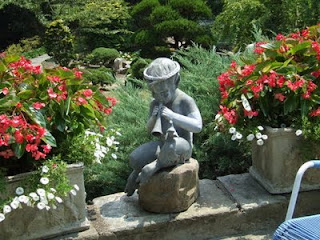It's been entirely too long since I've done one of these, so I'm going to make up for some lost time.
The Hillwood Estate is one of the more interesting, off-the-beaten path sites in DC. It was the home of Marjorie Merriweather Post, heiress to the Post cereal fortune, founder of General Foods, and with one-time husband E. F. Hutton the developer of Birdseye Frozen Foods. When she was married to Joseph Davies, the U.S. Ambassador to the Soviet Union during 1937 and '38, she lived in Russia and used her sizable fortune (she was, after all, the wealthiest woman in America) to purchase tons of Imperial Russian jewelry and treasures that would have otherwise been destroyed and melted down. These treasures were later kept in her DC home Hillwood, where she lived from 1955 to her death in 1973; with rare foresight, Miss Post (she resumed her maiden name after her fourth and last divorce) intended her home to be a museum after her death, and had hired a private curator and security experts.
It's a fascinating spot to visit, located in a ritzy residential neighborhood, very quiet and not the easiest place to reach by public transport (but it is possible). Security is very strict, and unsurprisingly so; the treasures are staggering and include a crown and a Faberge egg, and photography is forbidden inside the museum. (You'll have to check out the official website, or visit the place yourself.
But, when I was there, I took copious photos of the grounds and gardens, which are quite impressive...
Outside the main building.
An intriguing urn outside the house.
The equally intriguing entrance to the gardens. That ivied arch promises so much...
Perhaps the most aristocratic, and Frenchest, sphinx you'll ever see.
Inside the parterre garden, very French and very formal.
Diana! Goddess of the hunt! And probably a reflection on Post's independent spirit.
Some of the lovely roses.
Post's ashes reside in the base of that pillar, which is planted in the middle of the rose garden.
An honest-to-goodness putting green!
Post's "Friendship Walk" concludes in an overlook with four pleasant statues.
The Japanese Garden occupies a steep hillside; this is looking down from the top.
A pagoda in the Japanese garden, which also has quite a few Chinese influences. Asian garden, perhaps? Is "Oriental" too out of fashion?
Kwan Yin peeks out from the Japanese garden.
Ack! A lotus pond! Look out for murders!
This path leads to Post's private pet cemetery.
A most distinguished-looking lion overlooks the Lunar Lawn, the site of many glamorous garden parties in Hillwood's heyday.
Through the humid summer haze, you can just make out the top of the Washington Monument from the Lunar Lawn. An interesting reminder of the ideals of democracy, as seen from the portico of someone who lived like royalty.
An interesting astrological lamp near the Lunar Lawn.
And there's a greenhouse, full of orchids....
...and bonsai!
Touring Hillwood leaves one with all sorts of odd feelings. Post was criticized for taking so much of Russian cultural heritage out of the country, but you can't argue that by doing so she was preserving it for future generations. (Many priceless Russian treasures are now undoubtedly irrevocably lost, unless sitting in the vault of some Bondian collector villain.) And while I'm no fan of the Bolsheviks, it's easy for me to understand why there was a revolution when I see the wealth and glitter the upper classes bedecked themselves in, paid for with the sweat and blood of the workers. Of course, if it wasn't for the wealthy patrons, would great art exist? One of the great unanswerable questions. And while Post lived like royalty, she gave freely to many charities and intended from the start to leave Hillwood to the public as a museum.
Hillwood is still a great place to visit; they actively reach out to the local gay community (using the slogan "Where fabulous lives!") and have a number of gay-oriented events, as well as hosting other eccentric get-togethers, like the Seersucker Social that was organized by the local group Dandies & Quaintrelles. Admission is $15 for adults but when you consider the value of the collection that's actually pretty cheap.
When I wrote about Tudor Place, I compared it to a gracefully-aging old lady, clinging to her ways but keeping pace with the times. Hillwood is an exuberant grand dame who practically overwhelms you with her fabulousness, and leaves you feeling a bit enervated but also quite impressed. Both these ladies are worthy of a call when you're in town.
Sunday, August 7, 2011
Subscribe to:
Post Comments (Atom)
























No comments:
Post a Comment